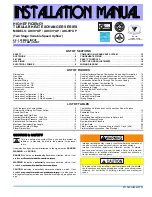
Page 33
The integrated control will do the following during calibra-
tion:
1 - Verify both low pressure switch and high pressure
switch are open. If either are closed log error and
end calibration.
2 - Start inducer at a predetermined low RPM (1600).
Wait 7.5 seconds.
3 - Check low pressure switch, if open, increase RPM
by 250, wait 5 seconds. Repeat this step until low
pressure switch is closed.
4 - Decrease RPM by 50, wait 5 seconds and look for
the low pressure switch to open. Repeat this step
until it is open.
5 - Keep this RPM as RPM1.
6 - Increase RPM by 1250. Wait 5 seconds.
7 - Check high pressure switch, if open, increase RPM
by 250, wait 5 seconds. Repeat this step until high
pressure switch is closed.
8 - Decrease RPM by 50, check after 5 seconds.
Repeat this step until switch is open.
9 - Keep this RPM as RPM2.
10 - Calibration complete.
NOTE -
If after a successful calibration and a heat call is
present the integrated control will by-pass the prepurge
state and go straight into ignitor warm up
After calibration, the integrated control stores the RPM1
and RPM2 values. The low fire (35%) and high fire (100%)
RPM points are calculated by adding margin values to the
RPM1 and RPM2 values.
The integrated control also initiates a low fire switch check
at the end of a normal heating cycle described below. If
this check fails the pressure switch calibration will follow
on the next call for heat.
1 -
The inducer runs 15 seconds at the last firing rate
before the heat call ended.
2 -
Inducer runs at 35% firing rate RPM (RPM1 + low
pressure switch open RPM margin value).
3 -
If low pressure switch is open, set flag for calibration
on next call for heat. Turn inducer off until next call
for heat.
4 - If low pressure switch is closed move inducer speed
to RPM1. Allow 5 seconds for stabilization.
5 -
If low pressure switch opens turn off inducer. No
further action.
6 - If low pressure switch is still closed, decrease
inducer speed 1/2 of the low pressure switch open
RPM margin. Allow 5 seconds to stabilize.
7 -
If low pressure switch is open turn off inducer. No
further action.
8 -
If low pressure switch is still closed, set flag for
calibration on next call for heat and turn off inducer.
Measuring pressure differential FIGURE 18
Checks of pressure differential can aid in troubleshooting.
Lennox provides a kit (10L34) if necessary. When measur-
ing the pressure differential, readings should be taken at
the pressure switch. Lack of differential usually indicates
problems in the intake or exhaust piping, but may indicate
problems in the heat exchanger, condensing coil, header
boxes, combustion inducer or other components.
The differential pressure is the difference in pressure
measured across the cold end header box orifice.












































